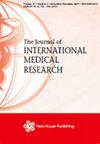钬激光碎石术后输尿管狭窄的回顾性研究
IF 1.4
4区 医学
Q4 MEDICINE, RESEARCH & EXPERIMENTAL
引用次数: 0
摘要
方法 对 106 名接受输尿管镜钬激光碎石术的患者进行了回顾性研究。结果逻辑回归分析显示,输尿管狭窄与结石位置、结石大小、手术时间、水摄入量、病程和结石相关息肉有显著相关性。结论钬激光碎石术的围手术期并发症与病程长、输尿管结石大、嵌顿时间长和息肉的存在有关。外科医生在对患者进行术前评估和手术规划时应考虑到这些风险因素,以最大限度地降低术后输尿管狭窄的风险。本文章由计算机程序翻译,如有差异,请以英文原文为准。
Retrospective study of ureteral stenosis after holmium laser lithotripsy
ObjectiveTo identify the factors influencing postoperative ureteral stenosis following holmium laser lithotripsy.MethodsA retrospective study was conducted of 106 patients who underwent ureteroscopic holmium laser lithotripsy. The effects of variables including stone location, stone size, the duration of surgery, water intake, disease duration, and stone-associated polyps were investigated.ResultsLogistic regression analysis revealed significant associations of ureteral stenosis with stone location, stone size, duration of surgery, water intake, disease duration, and stone-associated polyps. Patients with proximal stones, with large stones, who underwent long surgical procedures, who drank a large amount of water, who had long-term disease, and who had stone-related polyps were more likely to develop postoperative ureteral stenosis.ConclusionSignificant perioperative complications of holmium laser lithotripsy are associated with prolonged disease, large ureteral stones, long incarceration periods, and the presence of polyps. Surgeons should consider these risk factors during the preoperative evaluation of patients and surgical planning to minimize the risk of postoperative ureteral stenosis.
求助全文
通过发布文献求助,成功后即可免费获取论文全文。
去求助
来源期刊
CiteScore
3.20
自引率
0.00%
发文量
555
审稿时长
1 months
期刊介绍:
_Journal of International Medical Research_ is a leading international journal for rapid publication of original medical, pre-clinical and clinical research, reviews, preliminary and pilot studies on a page charge basis.
As a service to authors, every article accepted by peer review will be given a full technical edit to make papers as accessible and readable to the international medical community as rapidly as possible.
Once the technical edit queries have been answered to the satisfaction of the journal, the paper will be published and made available freely to everyone under a creative commons licence.
Symposium proceedings, summaries of presentations or collections of medical, pre-clinical or clinical data on a specific topic are welcome for publication as supplements.
Print ISSN: 0300-0605

 求助内容:
求助内容: 应助结果提醒方式:
应助结果提醒方式:


